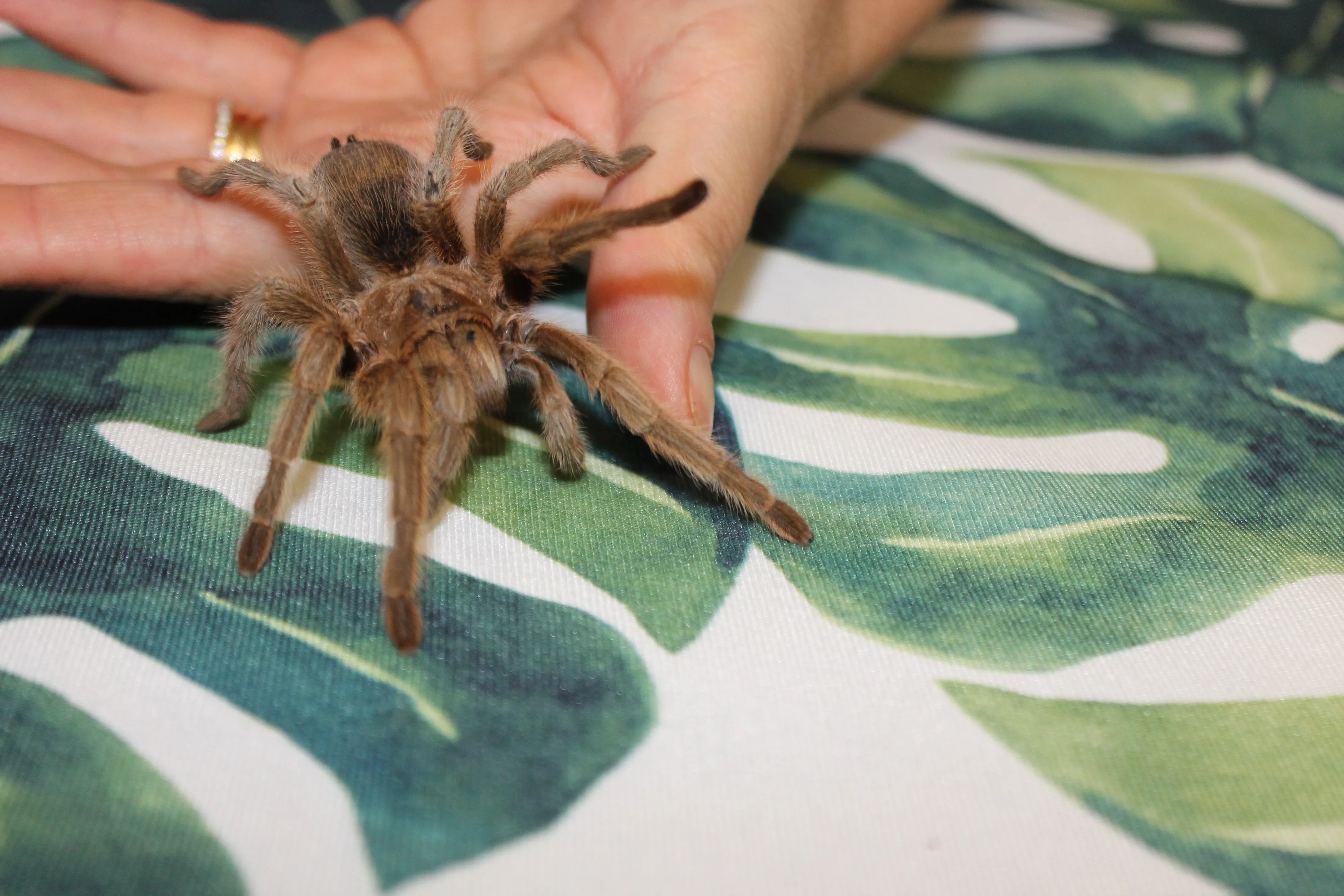What is a Tarantula?
Tarantulas are fascinating creatures that often spark curiosity. These large, hairy spiders belong to the Theraphosidae family, and they are found in various habitats across the globe, from the Americas to Asia and Africa. Known for their size and sometimes intimidating appearance, tarantulas are a popular subject of study and a common presence in the exotic pet trade. Understanding what a tarantula truly is, beyond its imposing size, is crucial for anyone interested in biology, arachnids, or simply curious about the natural world. These spiders are not insects, and understanding their basic characteristics is essential to compare them to amphibians.
Tarantula Classification
To understand where tarantulas fit in the animal kingdom, we need to look at their classification. They belong to the phylum Arthropoda, which includes all animals with an exoskeleton and segmented bodies. Within Arthropoda, they are classified under the class Arachnida, which includes spiders, scorpions, mites, and ticks. The order is Araneae, which encompasses all spiders, and finally, the family Theraphosidae, is where tarantulas reside. This classification helps scientists understand the relationships between tarantulas and other organisms, as well as their evolutionary history. This classification also highlights their key differences from amphibians which belong to a different class and phylum.
Arachnids Explained

Arachnids are characterized by having eight legs, two body segments (the cephalothorax, which is a fusion of the head and thorax, and the abdomen), and typically, no wings or antennae. Tarantulas, as arachnids, share these features. They use their eight legs for walking, climbing, and sensing their environment. Their cephalothorax houses the eyes, mouthparts (including fangs), and legs, while the abdomen contains the digestive and respiratory systems. The presence of chelicerae (fangs) and pedipalps (used for sensing and manipulating prey) are also defining features of arachnids. This contrasts sharply with amphibians, which have four limbs, a different body structure, and unique adaptations for both land and water.
What is an Amphibian?
Amphibians are cold-blooded vertebrates that typically begin their lives in water and later transition to land, although some remain aquatic. They include frogs, toads, salamanders, and newts. The term “amphibian” comes from the Greek words “amphi,” meaning “both,” and “bios,” meaning “life,” reflecting their dual lifestyle. Amphibians play a vital role in their ecosystems, serving as both predators and prey. Their permeable skin makes them particularly sensitive to environmental changes, making them excellent indicators of ecosystem health. Understanding their life cycle and adaptations is key to differentiating them from tarantulas.
Amphibian Classification
Amphibians belong to the phylum Chordata, the same phylum as mammals, birds, and reptiles, meaning they possess a notochord at some point in their development. Within Chordata, they belong to the class Amphibia. This class is further divided into three main orders: Anura (frogs and toads), Caudata (salamanders and newts), and Gymnophiona (caecilians). Amphibians share key characteristics such as their smooth, moist skin (in most species), a three-chambered heart, and the ability to breathe through their skin, lungs, and gills at different stages of life. Their classification highlights their fundamental differences from tarantulas, including their internal anatomy, development, and environmental needs.
Characteristics of Amphibians

The characteristics of amphibians are diverse. They have a unique life cycle often starting as aquatic larvae (tadpoles) with gills and transitioning into terrestrial adults with lungs. Their skin is permeable, allowing for gas exchange and water absorption, making them highly susceptible to dehydration and environmental toxins. Amphibians are ectothermic, meaning they rely on external sources to regulate their body temperature. This influences their distribution and behavior, as they are most active in warm, humid environments. They undergo metamorphosis, a dramatic physical transformation from larval to adult forms, a process entirely absent in the life cycle of tarantulas. Amphibians and tarantulas are fundamentally different in how they function and develop.
Fact 1 Tarantulas are Arachnids
As previously established, tarantulas are arachnids, belonging to the spider family. This immediately distinguishes them from amphibians, which are vertebrates. The classification alone highlights a fundamental difference in their evolutionary history and body plan. Arachnids have exoskeletons, which are external skeletons, while amphibians have internal skeletons. The exoskeleton of the tarantula must be shed to allow for growth, a process called molting. This difference in skeletal structure is a core distinction between the two groups, showing that the fundamental way in which the organisms are built is drastically different. The eight legs and two-part body of tarantulas set them apart from the four-limbed, three-part body of amphibians.
What Makes a Tarantula?
The defining features of a tarantula include its hairy body, eight legs, chelicerae (fangs), and pedipalps. They have spinnerets that produce silk, which they use to build webs, line their burrows, and wrap their prey. Their size varies depending on the species, with some tarantulas reaching a leg span of over 10 inches. They are predators, feeding on insects, small mammals, birds, and other invertebrates. Their bodies are covered in sensory hairs, which help them detect vibrations and movement. Their ability to inject venom is another key characteristic. None of these features align with the physical attributes of an amphibian, highlighting the distinct evolutionary paths they have taken.
The Physical Attributes

The physical attributes of tarantulas, such as their exoskeletons, hairy bodies, and fangs, are markedly different from the smooth, moist skin and limb structure of amphibians. Tarantulas have a hard, protective exoskeleton, while amphibians have permeable skin. Tarantulas use their fangs to inject venom, while amphibians employ different defensive strategies, such as skin secretions. The presence of spinnerets to produce silk for web-building is another characteristic unique to tarantulas. These physical differences emphasize the fact that tarantulas and amphibians are entirely separate groups of animals with no shared characteristics regarding their exterior design or physical functionality, proving their incompatibility.
Fact 2 Amphibians Live in Water and Land
A key characteristic of amphibians is their dependence on both aquatic and terrestrial environments. Their life cycle often begins in water, where they lay their eggs and their larvae develop. The aquatic environment provides protection and resources for early-stage development. As they mature, amphibians undergo metamorphosis, often developing lungs and legs to transition to a terrestrial lifestyle. This dual existence is a defining feature of amphibians, directly contrasting with the life cycle of tarantulas, which are entirely terrestrial.
Amphibian Habitats
Amphibians inhabit a wide range of habitats, from ponds and streams to rainforests and deserts. Their habitat choices are often dictated by their life cycle and the availability of water. They require moist environments to prevent dehydration and to facilitate gas exchange through their skin. The presence of water for breeding and larval development is crucial. The distribution of amphibians is influenced by factors such as temperature, humidity, and the presence of predators. This ecological need for water differentiates amphibians from tarantulas, which do not require a direct water source to live, other than humidity in their environments.
Amphibian Water vs Land

Amphibians have adapted to both aquatic and terrestrial environments. In water, they use gills to breathe and their skin to absorb water and oxygen. On land, they use lungs and skin for respiration. This ability to function in two different environments is a hallmark of amphibians. They have evolved various adaptations, such as webbed feet for swimming, specialized skin for gas exchange, and the ability to burrow to maintain moisture. Tarantulas, on the other hand, do not require water for their life processes and are fully adapted for a terrestrial lifestyle, with no aquatic phase in their life cycle.
Fact 3 Tarantulas are Not Amphibians
The fundamental classification differences between tarantulas and amphibians confirm that a tarantula is not an amphibian. Tarantulas belong to the class Arachnida within the phylum Arthropoda, while amphibians belong to the class Amphibia within the phylum Chordata. These distinct classifications reflect their evolutionary divergence and their vastly different biological characteristics. Their body plans, respiratory systems, reproductive strategies, and ecological roles are fundamentally different. This immediately excludes them from being the same type of animal. To suggest that they are the same demonstrates a fundamental misunderstanding of the animal kingdom.
Taxonomic Differences
Taxonomy, or the science of classifying organisms, clearly places tarantulas and amphibians into different classes, orders, and families. Tarantulas are arachnids, characterized by their exoskeletons, eight legs, and the absence of an internal skeletal structure. Amphibians are vertebrates, possessing an internal skeleton, four limbs (in most species), and a dual lifestyle. The taxonomic differences highlight their independent evolutionary trajectories. These taxonomic distinctions illustrate the distinct paths that tarantulas and amphibians have taken, emphasizing that they are not related in any way and do not belong to the same group.
Evolutionary Divergence

The evolutionary history of tarantulas and amphibians shows a clear divergence. Tarantulas evolved from ancient arachnids, adapting to terrestrial environments and developing unique characteristics such as venomous fangs and silk production. Amphibians evolved from aquatic ancestors, transitioning to land while retaining adaptations for both aquatic and terrestrial life. Their evolutionary paths show no overlap, with amphibians branching off much earlier in the tree of life. The separation of their evolutionary paths is clear when you look at the fossils, making it impossible to connect the two organisms.
Fact 4 Tarantulas Breathe Differently
Tarantulas and amphibians have vastly different respiratory systems. Tarantulas primarily breathe through book lungs, which are stacks of thin, leaf-like structures that absorb oxygen from the air. Some tarantulas also possess tracheae, a network of tubes that carry air directly to the tissues. Amphibians, on the other hand, utilize a combination of lungs, skin, and gills for respiration, depending on their stage of life and their environment. Their respiratory systems are adapted for both aquatic and terrestrial life, which includes the capability of breathing through their skin. The difference in how they extract oxygen underscores the distinct physiology and adaptations that separate these two groups.
The Tarantula Respiratory System
Tarantulas use book lungs, which are located in their abdomen, for respiration. Air enters these lungs through small openings called spiracles, and oxygen is absorbed into the hemolymph (the arachnid equivalent of blood). Some tarantulas also have tracheae, which are small tubes that deliver oxygen directly to the tissues, similar to insects. The efficiency of the tarantula respiratory system depends on the environmental conditions, such as humidity and temperature. Their respiratory system is designed for terrestrial life and is not suitable for aquatic environments, further distancing them from amphibians.
How Amphibians Breathe
Amphibians use a variety of methods for respiration, including lungs, gills, and skin. Tadpoles, the larval form of amphibians, have gills for extracting oxygen from water. As they metamorphose into adults, they develop lungs, and they can also breathe through their skin, which is permeable and allows for gas exchange. The lungs of amphibians are relatively simple compared to those of mammals, and their skin plays a significant role in respiration. The ability to breathe through the skin gives amphibians the advantage in aquatic environments, unlike tarantulas.
Fact 5 Similarities and Differences
While tarantulas and amphibians share some commonalities, such as being predators in their respective ecosystems, the differences far outweigh the similarities. Both groups play important roles in their habitats, but their ecological roles, body plans, and life cycles are vastly different. Tarantulas are primarily terrestrial predators, while amphibians have a dual lifestyle, utilizing both aquatic and terrestrial environments. Understanding these ecological roles helps emphasize their distinct places within the animal kingdom.
Commonalities in Habitat
Both tarantulas and amphibians can be found in various habitats, but their needs and preferences differ. Tarantulas thrive in warm, humid environments, often found in burrows or under rocks and logs. Amphibians require moist environments to prevent dehydration, but some can be found in drier regions. Both groups can be affected by habitat loss and environmental changes, making conservation efforts crucial. The shared need for specific environmental conditions is where their similarity ends, as their actual requirements and lifestyles are different, and the tarantula has a much stricter need for terrestrial habitats.
Differences in Reproduction and Life Cycle
The reproductive strategies and life cycles of tarantulas and amphibians are dramatically different. Tarantulas lay eggs, which hatch into spiderlings that resemble miniature versions of the adults. Amphibians, on the other hand, typically lay eggs in water, which hatch into aquatic larvae (tadpoles). These larvae undergo metamorphosis, transforming into adult forms. The development of tarantulas is a simple process, and amphibians undergo a drastic transformation, undergoing massive changes in their bodies. This difference in development alone is a solid reason why they cannot be in the same category.
Conclusion
In conclusion, the answer to the question “Is a tarantula an amphibian?” is a resounding no. The fundamental differences in classification, anatomy, physiology, and life cycle clearly separate these two groups. Tarantulas are arachnids, adapted for terrestrial life, while amphibians are vertebrates with a dual existence, relying on both water and land. Understanding these differences helps appreciate the diversity of life and the unique adaptations of each group. Therefore, it’s safe to say, tarantulas and amphibians are distinctly different creatures that don’t share a common classification.
